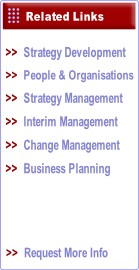


Copyright © 2003-

Bringing Strategy to Life
The most critical element in any strategy is its translation into reality. No matter the quality of the analysis or the synthesis and selection of strategy, the only true measure of success is in its execution. And the key to this is taking strategy off the page and giving it life within the organisation.
Ignetica personnel, as proven senior managers, have a wealth of experience in helping clients bring their strategy to life, and we have developed our portfolio of Strategic Support services based on this experience. From overall implementation advice, to detail operational support we have the breath of expertise to ensure delivery of your strategy, tailored to your specific needs.
We believe there are four key elements to effective strategy mobilisation;
The most critical element in any strategy is its translation into reality. No matter the quality of the analysis or the synthesis and selection of strategy, the only true measure of success is in its execution. And the key to this is taking strategy off the page and giving it life within the organisation.
Ignetica personnel, as proven senior managers, have a wealth of experience in helping clients bring their strategy to life, and we have developed our portfolio of Strategic Support services based on this experience. From overall implementation advice, to detail operational support we have the breath of expertise to ensure delivery of your strategy, tailored to your specific needs.
We believe there are four key elements to effective strategy mobilisation;
|
·
|
Strategic Purpose
|
|
·
|
Business Infrastructure
|
|
·
|
Guidance Systems
|
|
·
|
Resourcing
|
Strategic Purpose: A clear and effectively communicated strategic purpose (what it is you are trying to do and why) is the essential starting point in bringing strategy to life. But it can’t just be about top down direction. Although it needs to be led from the top, widespread enrolment with multiple points of change is essential in overcoming inertia. And this isn’t a one off communications event, it needs to live and breathe and be continuously supported. Importantly its not just the formally communicated messages, but the informally perceived messages derived from management behaviour, rewards and recognition which are key.
Clear (and relevant) strategic purpose, vision and mission provide one of the key bases to generate the organisational motivation needed to translate strategy into reality. But it’s also about leadership. Where management is principally task orientated (getting things done), leadership needs to provide the orientation, excitement and credible vision of the future with which to gain commitment and engagement.
In his book, “Jack”, Jack Welch the highly respected former CEO of GE, highlights the importance of building a shared exciting vision with the warning that “nobody is motivated by a number”. Whilst the performance management regime, including goals, objectives and targets is also a key element of strategy implementation this is the control and not the heart.
Business Infrastructure: By business-
Guidance Systems: These are the mechanisms that steer the focus of management attention, action and decision-
Each of these elements must work effectively to ensure strategy is accurately translated into day to day operations, and delivered according to plan. But it’s not just one way. It’s also essential to ensure a two-
Resourcing: Having the right skills, at the right time in the right quantities, is essential to any business function. In the case of strategy, having the right human resourcing to focus its delivery is key. All too frequently good strategic planning fails to translate into reality, because operational management time is diverted to the crisis of the day, and strategy falls by the way side. Its also import that people all levels feel enabled to take ownership and have the right skill to deliver and lead the strategy in the area they are responsible for.
Examples of the specific programme include;
|
·
|
Produce Strategy, Purpose and Vision
|
|
·
|
Develop Organisational Alignment Programmes
|
|
·
|
Co-
|
|
·
|
Business Infrastructure audit
|
|
·
|
Business Infrastructure Optimisation
|
|
·
|
Organisation and Process Design
|
|
·
|
Guidance System Audit
|
|
·
|
Guidance System Optimisation
|
|
·
|
Performance Mgt System design
|
|
·
|
Co-
|
|
·
|
Provide interim resourcing
|
|
·
|
Provide management training
|

